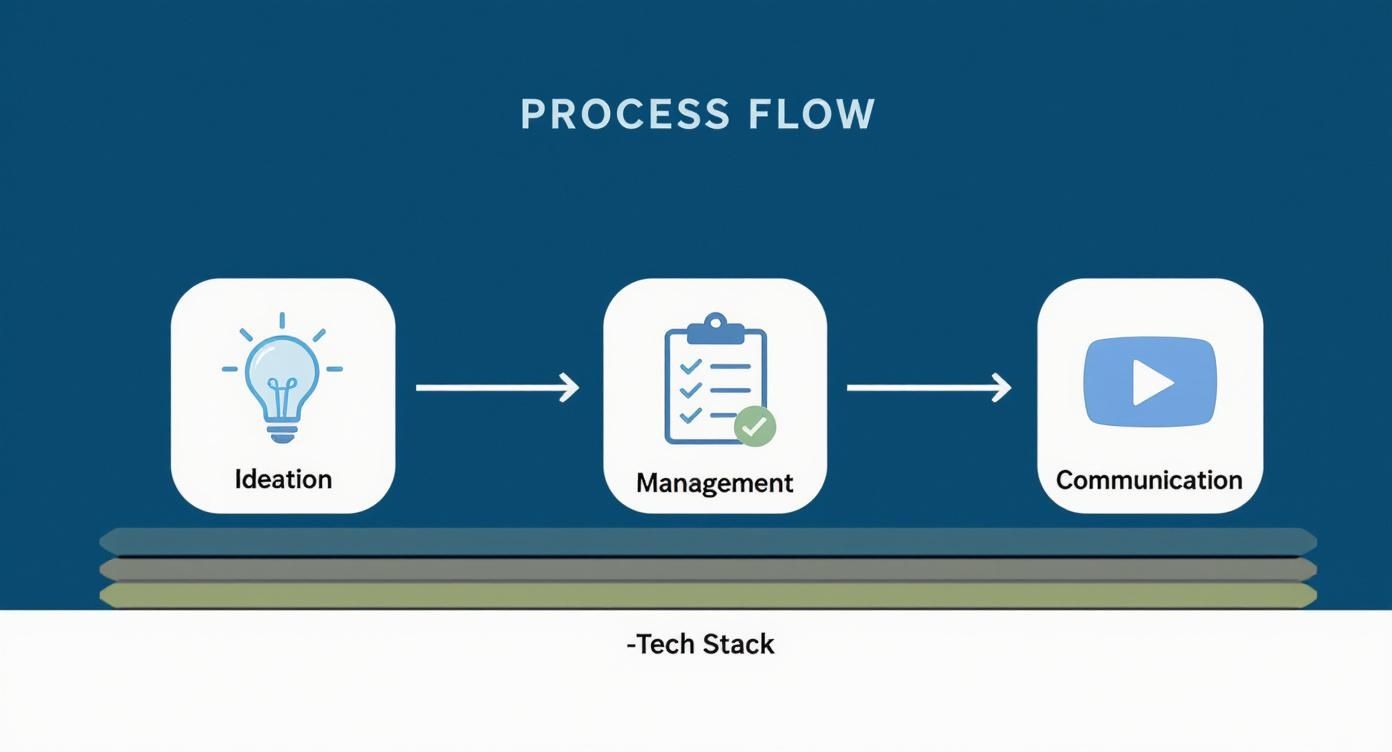Another product launch pushed back? It's a frustratingly common story. But reducing time to market isn't just another corporate buzzword—for a remote team, it's the key to staying competitive and growing. It directly hits your revenue, your slice of the market, and where you stand against everyone else.
Why Speed Is Your Ultimate Advantage
In the world we live in, being first matters. A lot. The first-mover advantage isn't a myth; it often decides who wins in the long run. Getting your product to customers before anyone else does more than just win a race. It lets you set the market standard, grab that initial customer base, and cement your brand as the one to beat.
Even small delays can be devastating. They create an opening that your competitors will jump at the chance to fill.

For remote teams, this challenge is even bigger. You don't have those casual, in-person moments that often keep things moving. Processes can easily get tangled, creating bottlenecks that bring everything to a grinding halt. A simple decision can disappear in a chaotic Slack channel, or a critical task gets missed until it’s already causing a fire.
The Real Cost of Dragging Your Feet
Every single week your launch is delayed costs you real money. I'm not just talking about the revenue you're not making yet. Think about the extended development costs, the marketing campaigns you've paid for that are now on ice, and the market opportunity that's shrinking by the day.
The upside of moving fast is huge. Studies have found that products that beat competitors to market see 15-20 percent higher market penetration and often get to charge more. It’s a stark reminder that speed isn't just about efficiency; it's a financial strategy.
The greatest danger in times of turbulence is not the turbulence; it is to act with yesterday’s logic. – Peter Drucker
A Game Plan for Moving Faster
To get past these remote work hurdles, you need a solid game plan—a framework that connects everything from the first idea to the final launch. This means bringing in methods built for speed and efficiency. A great starting point is understanding the core ideas of DevOps, which is all about building this kind of advantage. If you want to dive deeper, this technical guide to DevOps methodology is a fantastic resource.
This guide will give you that framework. We're going to skip the high-level theory and get right into the practical steps your team can start using today to speed up the entire product cycle. We’ll cover proven techniques for:
- Smarter remote brainstorming to get to great ideas quicker.
- Crushing decision-making bottlenecks with clear roles and simple frameworks.
- Speeding up the execution phase with agile practices and the right automation.
Mastering Remote Brainstorming and Ideation
A faster launch always starts with a smarter idea. But for remote teams, this initial brainstorming phase can quickly become a huge bottleneck, killing momentum before you even get going. We've all been there—endless video calls that drain energy instead of sparking creativity, or unstructured Slack threads that just turn into a mess of disconnected thoughts.
To really shrink your time to market, you have to ditch these broken methods. Forget trying to recreate a physical whiteboard session over a choppy video call. The real secret for distributed teams is a hybrid approach, one that mixes the buzz of real-time collaboration with the quiet focus of asynchronous work.

Run Time-Boxed Idea Sprints
Instead of booking one long, draining brainstorming meeting, try breaking the process into short, high-energy sprints. This method respects everyone's schedule and keeps the creative fire burning. Remember, the goal here is rapid-fire idea generation, not finding the perfect solution on the spot.
Here’s a simple structure I’ve seen work wonders:
- Set the Stage (15 mins): Get everyone onto a shared digital whiteboard like Miro or FigJam. Make sure the problem you're trying to solve is clearly stated right at the top. Give people a few minutes to silently read the brief and any background info.
- Silent Brainstorming (20 mins): Now, everyone starts adding their ideas to the board using digital sticky notes. The silence here is key. It stops groupthink in its tracks and ensures your more introverted team members have just as much space to contribute.
- Group & Theme (15 mins): Once the board is full of ideas, you work together to drag related stickies into clusters. You're just organizing, not debating. This is all about spotting the emerging themes.
- Dot Voting (10 mins): Give everyone three "dots" to vote on the ideas or themes they feel have the most promise. This is a super-fast way to see which concepts are resonating with the group without getting bogged down in discussion.
This whole process clocks in at just one hour, yet it produces far more focused results than a typical three-hour slog of a meeting. If you want to explore this further, our guide on https://www.remotesparks.com/virtual-brainstorming/ has even more techniques you can try.
Choosing Your Brainstorming Method
Not all brainstorming sessions are created equal. Depending on your goal, you might lean toward a live session, an async approach, or a mix of both. Here’s a quick comparison to help you decide what's right for your team at any given moment.
Comparing Brainstorming Methods for Remote Teams
| Method | Best For | Key Advantage | Potential Pitfall |
|---|---|---|---|
| Synchronous | Kicking off a project, exploring a broad problem, building team alignment | High energy and rapid idea flow | Can favor louder voices; difficult to schedule across time zones |
| Asynchronous | Gathering detailed feedback, refining existing ideas, including a global team | Allows for deep, thoughtful contributions from everyone | Lacks immediate feedback; can lose momentum if not managed well |
| Hybrid | Moving from broad ideas to a concrete plan, validating concepts quickly | Combines the energy of live sessions with the depth of async feedback | Requires clear handoffs between the synchronous and asynchronous phases |
Ultimately, the hybrid model often gives you the best of both worlds, which is why it's so effective for moving quickly from initial idea to a refined concept.
Use Asynchronous Feedback to Refine Ideas
After the energy of the live sprint, the real work of refining those ideas begins asynchronously. This is your escape from meeting hell. It's where thoughtful, considered feedback can actually happen. Take the top-voted ideas from your sprint and move them into a dedicated Slack channel, a Notion page, or whatever tool your team uses.
Then, give everyone a clear deadline—usually 24 to 48 hours—to add their comments, ask questions, and build on the ideas. This async window lets people contribute when they're at their sharpest, which almost always leads to better, more insightful feedback. To really get this right, it helps to understand some effective ideation strategies.
I worked with a SaaS company that used this exact hybrid model to nail down a new feature concept. Their old process took two weeks of painful back-and-forth meetings. By switching to a one-hour Miro sprint followed by a two-day async feedback loop in Slack, they locked in the entire concept in just three days.
This system just works. It harnesses the spontaneous energy of a live brainstorm and pairs it with the space needed for deep, reflective thinking. By giving both phases a clear structure, you build a powerful engine for generating and vetting ideas fast, giving you a solid foundation and a serious head start.
Breaking Through Decision-Making Bottlenecks
Nothing kills momentum like a project stuck in limbo. For remote teams, this is a constant threat. Without the quick chats you'd have in an office, a simple question can turn into a week-long Slack debate, and suddenly, your launch date is slipping. Progress just stalls while everyone waits for one person to give the thumbs-up.
The answer isn't to schedule more meetings—it's to create clarity. When your team knows who owns a decision and how that decision gets made, things start moving again. A few simple frameworks can make all the difference.
Who Owns the Decision? Use the DACI Framework
If you've ever been in a meeting where no one knows who has the final say, you know how frustrating it can be. The DACI framework is brilliant because it cuts through that confusion by assigning everyone a clear role before the work even starts.
It's a simple acronym that defines who does what:
- Driver (D): This is your project point person. They’re responsible for getting all the right info, laying out the options, and making sure a decision actually happens.
- Approver (A): The single person who makes the final call. They have veto power, and the buck stops with them.
- Contributors (C): These are your subject matter experts. They provide the crucial input and context, but they don't get a vote.
- Informed (I): Anyone who needs to know the outcome after the decision is made. They aren't directly involved in the process itself.
Defining these roles upfront stops "decision by committee" dead in its tracks. It's perfectly clear who needs to be consulted and, ultimately, who signs off. We cover more on this in our guide to decision-making in groups.
Learn to Disagree and Commit
Waiting for everyone to agree 100% on something is a surefire way to go nowhere fast. A much healthier and faster approach is the "disagree and commit" principle.
It’s a simple but powerful idea: once the designated Approver makes a decision, the entire team gets behind it. Period. Even if they argued for a different path.
Think of a product team debating between two feature designs. After a healthy debate, the Approver (the Product Manager) chooses Design A. The engineers who preferred Design B have had their say, their points were heard, and now they put their full effort into building Design A to the best of their ability. No foot-dragging, no passive resistance—just a commitment to moving forward together.
It's absolutely essential to document these decisions and the "why" behind them in a central place like Notion or Confluence. This creates a transparent record that builds trust and keeps everyone aligned.
Use Data to Move Faster, Not Slower
Making quick decisions doesn't mean you have to wing it. The trick is to have your data ready before you need it and to set clear triggers for action.
Don't wait for someone to pull a report. Instead, build automated dashboards in tools like Google Analytics or Datadog that give you a real-time pulse on your key metrics.
For example, you could establish a rule: "If new trial sign-ups drop below 50 per day for three days straight, we automatically roll back the last feature release." This removes all the guesswork and empowers the team to act instantly without calling a meeting.
History shows that speed matters. According to the Project Management Institute, projects delivered on time are 70 percent more likely to hit their budget and scope targets. You can dig deeper into how market timing affects business success in this global market outlook.
When you combine clear roles, a bias for action, and accessible data, you build a culture where confident decisions keep projects on the fast track to launch.
Speeding Up How Your Remote Team Builds and Ships
You've got a killer idea and a green light to move forward. Now for the fun part: actually building the thing. This is where your validated concepts become a real product people can use. For remote teams, this execution phase is all about tight coordination, clear communication, and keeping the momentum going. It's about finding a rhythm that doesn't get tripped up by different time zones or conversations lost in a dozen Slack channels.
Let's be honest: reducing your time to market comes down to how well your team can execute. A clunky, slow delivery process will erase any speed you gained during brainstorming and decision-making. The real goal here is to create a well-oiled machine where work flows seamlessly from one stage to the next.

This is precisely where agile methods come into their own, especially for remote work. The data doesn't lie. A PwC survey revealed that a whopping 77 percent of top-performing product teams lean on agile practices. The result? They can cut their time to market by a huge 25-50 percent. The financial upside is just as compelling. McKinsey found that even a 20 percent shorter development cycle can crank up revenue growth by as much as 30 percent.
Nail Your Remote Agile Workflow
Daily stand-ups over video can feel like a chore, especially when you're coordinating across the globe. A simple but powerful switch is moving to asynchronous stand-ups. Using tools like Geekbot in Slack lets team members share updates on their own time, keeping everyone in the loop without breaking their focus.
A well-organized Kanban board in a tool like Jira or Trello is your best friend for visualizing work. This isn't just a fancy to-do list; it's a diagnostic tool. By mapping out your workflow—from "To Do" to "In Progress" to "Done"—you can see exactly where things are getting stuck.
A packed "Code Review" column isn't a sign that your developers are slow. It's a sign of a process bottleneck. This kind of visibility lets you solve problems before they throw your entire sprint off track.
Run Work in Parallel, Not in a Straight Line
One of the biggest drags on development speed is thinking in a straight line. Whenever you can, run tasks in parallel. While your backend team is building a new API, for example, the frontend team can be crafting the user interface using mock data. There's no need for them to wait around.
I once worked with a team that was trapped in a rigid three-week sprint cycle. It felt like they were always waiting on each other. We completely re-jigged their workflow to run frontend and backend development at the same time and automated their entire testing suite. The result? They shrunk their cycle down to two weeks, shipping features 33% faster. Diving into sprint planning best practices can uncover similar opportunities for your own team.
Automate Absolutely Everything You Can
Manual, repetitive tasks are silent killers of productivity and speed. Every single minute a developer spends on a manual deployment or running tests by hand is a minute they aren't writing code. This is where a serious focus on automation and DevOps principles can give you a massive advantage.
- CI/CD is non-negotiable: Implement Continuous Integration/Continuous Deployment pipelines with tools like GitHub Actions or Jenkins. This automates building, testing, and deploying your code, which eliminates manual errors and radically shortens release times.
- Automate your tests: Your unit, integration, and UI tests should all be automated. This creates a safety net, allowing developers to code faster and with more confidence because they know any regressions will be caught immediately.
By building a culture where automation is the default, you create a system where everyone contributes to a faster, more reliable delivery process. You'll not only ship faster but also deliver a much higher-quality product.
Your Essential Tech Stack for a Faster Workflow
Let's talk tools. Getting your tech stack right is make-or-break for a fast-moving remote team. The goal isn't to sign up for every shiny new app; it's about picking a handful of tools that work beautifully together, cutting out the friction that slows you down.
Think of your tech stack as the central nervous system of your team. It should make it effortless for ideas, decisions, and tasks to flow from one stage to the next, helping you reduce your time to market.
For Kicking Off Ideas and Brainstorming
Your team needs a digital space that feels just like a real whiteboard room—maybe even better. This is where a tool like Miro really shines. It's basically a limitless canvas where everyone can jump in at the same time.
Miro is perfect for those time-boxed idea sprints we talked about. Your team can throw up digital sticky notes, sketch out diagrams, and build mind maps together in real-time. It brilliantly captures that initial creative spark and keeps it all organized in one place, creating a living document of your team's thinking.
For Turning Ideas into Action
Once an idea gets the green light, you need a system to translate it into concrete tasks. We've found that Asana is fantastic for this. It brings immediate clarity to the classic "who is doing what by when?" question.
Its visual timelines and Kanban boards are a lifesaver for spotting potential roadblocks before they become actual problems. For a remote team, Asana becomes the single source of truth for project status, which means fewer "just checking in" pings and more focused work. If you want to dive deeper into tool selection, this guide on collaboration tools for distributed teams is a great resource.
A Quick Story: I once worked with a design team that was constantly bogged down by feedback cycles. A simple mockup review could take days of back-and-forth emails. They switched to using Loom for quick, five-minute video walkthroughs of their designs. The difference was night and day. They cut their design review cycle from four days down to just one.
For Keeping Everyone in Sync (Without Meetings)
Async communication is the secret weapon of efficient remote teams. A tool like Loom is invaluable here. Instead of typing out a long, confusing email, you can just record your screen and voice to explain a complex concept or give feedback. It’s faster, clearer, and brings a human touch that text just can't match.
Finally, you need a permanent home for all your important knowledge. We use Notion as our team's central brain. It’s where we document everything from our DACI assignments to the "why" behind a big product decision. This creates a transparent, searchable record that keeps the whole team aligned, which is especially helpful when new people join.
Your Action Plan for Faster Product Launches
Alright, let's put all this theory into practice. Shrinking your time to market isn't about skipping steps or rushing the work. It's about being smarter, trusting your remote team, and building a system that moves ideas from concept to launch with less friction.
This whole process boils down to three core ideas. First, you need structured brainstorming to land on solid, validated concepts quickly. Second, you have to make decisions without endless debate stalling everything. Finally, an agile approach to execution helps you build a rhythm of constant delivery. When you get these three pieces working together, you create a powerful engine for speed.
This infographic shows how the right tools can support each phase, from the initial spark of an idea all the way to launch day.

As you can see, the real magic happens when your ideation, project management, and communication tools all talk to each other seamlessly.
Your Go-Forward Checklist
To make this framework a reality, you need a simple checklist your team can start using tomorrow. Think of this less as a to-do list and more as a commitment to a new way of operating.
- Run Timed Brainstorms: Instead of endless open-ended discussions, use time-boxed sprints on a digital whiteboard. This gets everyone contributing ideas quickly and on equal footing.
- Define Who Decides: For any big initiative, use a framework like DACI to assign roles. The most important rule? There must always be one, and only one, designated Approver.
- Default to Async: Make asynchronous updates and feedback the standard. This cuts down on meeting overload and is a lifesaver for teams spread across different time zones.
- Make Your Workflow Visible: Get everything onto a shared Kanban board. It’s the easiest way to see where work is flowing smoothly and where it’s getting stuck.
- Automate Everything You Can: Set up CI/CD pipelines and automated testing. Every manual, repetitive task you can eliminate is time you get back to build better products.
I once advised a startup that went from a sketch on a napkin to a live product with paying customers in just 90 days. They didn't have a huge budget or a massive team. What they had was a fanatical dedication to these principles, which turned their remote setup from a challenge into a major advantage.
They nailed the handoffs between each stage, so the project never lost steam. If you want a more granular guide, our product launch checklist breaks it all down step-by-step.
When you have the right process, your team can move with confidence. Faster launches stop being a lucky break and start becoming the new normal.
Ready to transform your team's creative process? Bulby provides the guided, structured brainstorming exercises that remote teams need to generate brilliant ideas faster. Discover how Bulby can unlock your team's potential.

